Tuesday, November 29, 2005
Materan Museuming
Last night (was it only last night?) I visited the archaeology museum in Matera, in Basilicata. You know it as the setting of countless movies with "historical" Near Eastern settings, e.g. the Passion of Mel Gibson, because of its sassi, millenia-old stone dwellings carved directly into the hillside. It was dark when we got there, it having been one of those last-minute trips, but the museum was open for another hour. They didn't have change for a €50 bill, and after I changed it they couldn't work with a ten either, so I ended up with admission gratis. I was the only one there, and a couple of times the lights in the galleries got turned off, only to be turned on again moments later after I shuffled distinctively. A wonderful little museum; they have an Apulo-Corinthian helmet from a site in the region (always nice to see provenience!), as well as numerous Italiote vases (that is, figured vases, like the ubiquitous Attic black- and red-figure, but produced in Italy and, in this reporter's opinion, more fun).
Olive harvest continues. We're down to the three Americans and the local foreman Pasquale, the others having departed for Slovakia this afternoon. They (and their taste for whiskey) will be missed.
Olive harvest continues. We're down to the three Americans and the local foreman Pasquale, the others having departed for Slovakia this afternoon. They (and their taste for whiskey) will be missed.
Wednesday, November 23, 2005
Moving south
A few days ago I arrived in Puglia, near the town of Toritto, about 20 km from Bari. I'm helping with the olive harvest. There's a machine that shakes the branches to knock the olives down onto big mats spread underneath. When the machine breaks, though, we have to go at the trees with long poles, much like those shown on some Attic figured vases. There are two other Americans, who arrived the day before I did, and three Slovaks who've been here for three months and are quite ready to go home. It rained all night and most of the day, so the soil was far too soggy to work.
I got here two days later than I'd planned because... the morning I was supposed to leave, before I went to the train station, I decided to check to see if the museum in Boiano was open. It just happened to be so, because the Soprintendenza was making an inspection. Quite small, but some nice Oscan brickstamps and some tombgroups from the area. On the way out, I saw a poster for the 'Premio Salmon', an annual award for local high-schoolers who excel in Greek, Latin and Ancient History. It's named for the man who wrote the book on the Samnites (Samnium and the Samnites), E. Togo Salmon, a Canadian historian. The ceremony is preceded by a lecture, which I decided to stay for. A nice presentation on settlements in south-central Italy in the 4th and 3rd cent. BCE. There were also a few remarks by professor Gianfranco De Benedittis, a very eminent Italic archaeologist. My 30 minutes are nearly up, so that's it for now.
I got here two days later than I'd planned because... the morning I was supposed to leave, before I went to the train station, I decided to check to see if the museum in Boiano was open. It just happened to be so, because the Soprintendenza was making an inspection. Quite small, but some nice Oscan brickstamps and some tombgroups from the area. On the way out, I saw a poster for the 'Premio Salmon', an annual award for local high-schoolers who excel in Greek, Latin and Ancient History. It's named for the man who wrote the book on the Samnites (Samnium and the Samnites), E. Togo Salmon, a Canadian historian. The ceremony is preceded by a lecture, which I decided to stay for. A nice presentation on settlements in south-central Italy in the 4th and 3rd cent. BCE. There were also a few remarks by professor Gianfranco De Benedittis, a very eminent Italic archaeologist. My 30 minutes are nearly up, so that's it for now.
Thursday, November 17, 2005
Pilgrimage to Pietrabbondante
After spending the whole morning in Agnone, I caught a bus to Pietrabbondante around 2 pm. There are two big rocks that loom over the town (hence the name -- "abundant rocks"), and many smaller ones that do more lurking than looming. I descended from the bus in the main square, where a brazen Samnite warrior glared down upon me from his commemorative pedestal. The ancient site is a bit of a walk from the town, but it gives a good panoramic view:
By happy coincidence, the Samnites built their theater-temple complex on Mommsen Street:

It's generally agreed that Pietrabbondante, whatever its ancient name, was the foremost sanctuary and meeting place of the Samnites, regardless of tribe. It's likely that the legio linteata ("Linen Legion"), the crème de la crème of the Samnite fighting forces, was mustered here before its defeat at Aquilonia in 293 BCE.
This, the signs all say, is the greatest monument left by the Samnites:
 It's called "Temple B," and it dates to the end of the 2nd century BCE. The section of standing wall was reconstructed by archaeologists from fallen blocks. Below Temple B and on the same axis is a theater...
It's called "Temple B," and it dates to the end of the 2nd century BCE. The section of standing wall was reconstructed by archaeologists from fallen blocks. Below Temple B and on the same axis is a theater...
Idle thoughts
I'd like to visit Egypt -- the past few months I've been thinking a lot about Alexandria. But this is not the time.
Wednesday, November 16, 2005
Agnone Adventures
The day after Capua, Mario was going to Rome, so I had him drop me off in Isernia with the intention of catching a bus to Pietrabbondante. As it happened, there was no direct connection, so I went to Agnone first, which is a bit northwest of Pietrabbondante. I had about an hour to kill, and I knew there was a replica of the Oscan 'Table of Agnone' floating around (the original is in the British Museum), so I decided to investigate. At the first bar, I learned that a copy was housed in the church of , and thence I went. The church, however, was closed and locked; since it was only 9:30, I figured I'd try back after 10. In the meantime, I hoofed it to the centro storico looking for picturesque alleyways and maybe some spolia. I was passing the Municipio (town hall) and happened to glance through the open doorway. I spied a courtyard, and since antiquities are often to be found in such places, I stepped in. Two gentlemen strolling under the modest collonade asked my business, and I said I was looking for the reproduction of the Oscan tablet. It seemed I was in luck: there was one in the library upstairs. Upon arrival, however, it was not to be found. I was led down the hall to the office of some petty magistrate whose closet, as it happened, contained a replica in plastic. Just after getting the thing in my greasy little fingers, another man entered and informed us that the more true-to-life copy in bronze was being used for a class, and would I like to sit in? Shortly thereafter I was introduced to a class of about twenty ten-year olds as an "archaeologist from the United States very interested in the Oscan tablet" and shown a seat. The man teaching the class (who incidentally looked a bit like Rex Wallace) then turned to me, raised an eyebrow and said, "I know you." It turned out he was a journalist I'd been introduced to while helping Mario sell cheese at the Truffle Fair in S. Pietro Avellana a week prior... In any case, I got a 45-minute refresher course on Samnite history (in Italian, naturally). After the kids were dismissed, I got to take a look at the replica tablet and talked with Nicolà for quite some time.


His three great loves, it turns out, are the Samnites, tratturi, and horses. After picking up his kids from school, he drove me to the outskirts of town to show me the remains of the massive Samnite fortification walls:
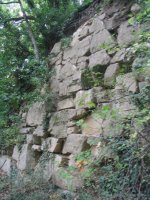
We don't know the ancient name of Agnone; Nicolà suggested Aquilonia, site of the decisive Roman victory against the Samnite legio linteata in 293 BCE, but that seems to me to be more wishful thinking on his part. Whatever the case, he kept stressing the fact that the site has never been excavated and hinted that it might be a good place for my future work... I think it pained him to live so close to such a site and know so little about it. But it was time for me to catch another bus to Pietrabbondante, as the first one had departed hours before.


His three great loves, it turns out, are the Samnites, tratturi, and horses. After picking up his kids from school, he drove me to the outskirts of town to show me the remains of the massive Samnite fortification walls:

We don't know the ancient name of Agnone; Nicolà suggested Aquilonia, site of the decisive Roman victory against the Samnite legio linteata in 293 BCE, but that seems to me to be more wishful thinking on his part. Whatever the case, he kept stressing the fact that the site has never been excavated and hinted that it might be a good place for my future work... I think it pained him to live so close to such a site and know so little about it. But it was time for me to catch another bus to Pietrabbondante, as the first one had departed hours before.
Monday, November 14, 2005
Capua Recap
On the 8th of November I had the opportunity to visit Capua for several hours. The modern city is located on the site of ancient Casilinum, the river port of (pre-)Roman Capua, which is today Santa Maria Capua Vetere. As I was only tagging along while Mario went to Caserta a bit further on, I got there later than I'd hoped. Consequently I had only an hour to zoom through the rich and fabulous Museo Provinciale Campano before it closed for the afternoon and the day. When that's the case, I usually photograph everything and sort through it later; unfortunately, almost the entirety of the indoor galleries were No Foto Zones. Since I was the only person daft enough to be visiting at 12:30 in the middle of the week in the middle of November, I had my own personal "tour guide" -- read camera monitor. Be that as it may, it was still a great museum and I did take a few pictures:

A Roman mosaic full of young 'uns. Actually, a so-called "sacred choir" (makes me think of the Carmen Saecvlare) from the temple of Diana Tifatina. This was the picture that prompted the admonition "Vietato fare foto." Now, all those kids gotta come from somewhere...
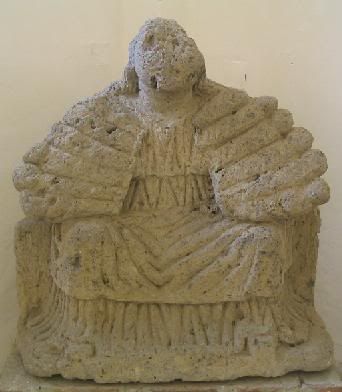
...and that's where Mater Matuta comes in (though these date between the 6th and 2nd centuries BCE -- well before the mosaic). There are several galleries filled with statues of this sort -- I don't remember, but I believe there are over a hundred in the collection. They come from an Italic sanctuary nearby, and were probably ex voto dedications: an expecting mother would vow to set up a statue to the goddess if childbirth went easily. Numbers of children held range from one to twelve (seen here). Jumping forward again to Roman imperial times...
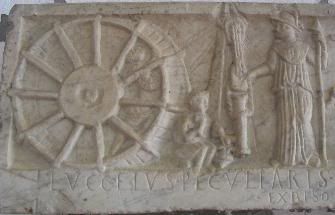
This is a detail of the left half of a relief, showing a man-powered crane lifting a column into place, the goddess Minerva in attendance. The inscription reads:
Lucceius Speculiaris redemptor prosceni fecit ex biso
"Lucceius Speculiaris the theater contractor made (this) after a vision."
I didn't have time to see the iuvilas-inscriptions (in Oscan), which are by request only. In any case, I plan to come back and spend at least a day, maybe a week. I spent the rest of the day wandering up and down practically every street in the center of Capua. It's rich in spolia, that is, ancient inscriptions and architectural bits reused in later buildings. For example:

The church of S. Angelo in Audoaldis, which dates from the 11th c (CE). At the base of the tower you can see three or four reused Roman funerary stones.
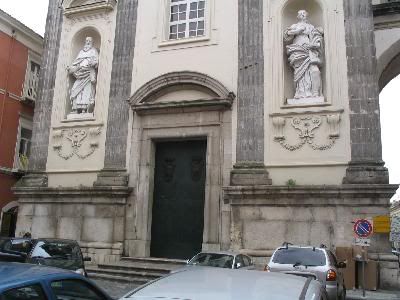
The church of the Annunziata. Those familiar-looking blocks that form the base (and not only in front -- they stretch around the entirety of the rather long structure) come from the Roman amphitheater in S. Maria Capua Vetere. In fact, the entire modern city of Capua was built from the remains of that amphitheater. Indeed, no one in Europe has cut building stone since the fall of the Roman Empire. It's more efficient to go down to your friendly neighborhood Roman ruins and take what you need, plus it saves the environment by reducing the need for ugly quarries. Everybody's happy...
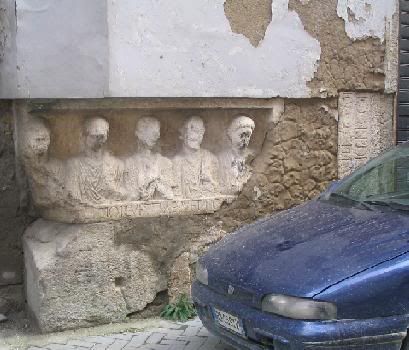
There are at least five pieces of spolia in this picture. Can you find them all? As the sun sets, farewell to Capua for now. Watch this space for exciting updates over the next several days.
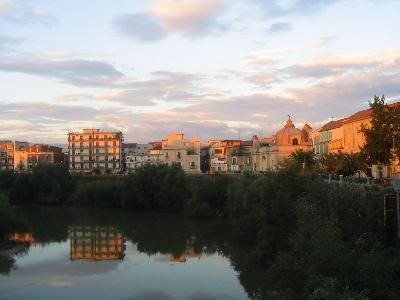

A Roman mosaic full of young 'uns. Actually, a so-called "sacred choir" (makes me think of the Carmen Saecvlare) from the temple of Diana Tifatina. This was the picture that prompted the admonition "Vietato fare foto." Now, all those kids gotta come from somewhere...

...and that's where Mater Matuta comes in (though these date between the 6th and 2nd centuries BCE -- well before the mosaic). There are several galleries filled with statues of this sort -- I don't remember, but I believe there are over a hundred in the collection. They come from an Italic sanctuary nearby, and were probably ex voto dedications: an expecting mother would vow to set up a statue to the goddess if childbirth went easily. Numbers of children held range from one to twelve (seen here). Jumping forward again to Roman imperial times...

This is a detail of the left half of a relief, showing a man-powered crane lifting a column into place, the goddess Minerva in attendance. The inscription reads:
Lucceius Speculiaris redemptor prosceni fecit ex biso
"Lucceius Speculiaris the theater contractor made (this) after a vision."
I didn't have time to see the iuvilas-inscriptions (in Oscan), which are by request only. In any case, I plan to come back and spend at least a day, maybe a week. I spent the rest of the day wandering up and down practically every street in the center of Capua. It's rich in spolia, that is, ancient inscriptions and architectural bits reused in later buildings. For example:

The church of S. Angelo in Audoaldis, which dates from the 11th c (CE). At the base of the tower you can see three or four reused Roman funerary stones.

The church of the Annunziata. Those familiar-looking blocks that form the base (and not only in front -- they stretch around the entirety of the rather long structure) come from the Roman amphitheater in S. Maria Capua Vetere. In fact, the entire modern city of Capua was built from the remains of that amphitheater. Indeed, no one in Europe has cut building stone since the fall of the Roman Empire. It's more efficient to go down to your friendly neighborhood Roman ruins and take what you need, plus it saves the environment by reducing the need for ugly quarries. Everybody's happy...

There are at least five pieces of spolia in this picture. Can you find them all? As the sun sets, farewell to Capua for now. Watch this space for exciting updates over the next several days.

Sunday, November 06, 2005
What's in your saddlebag?
When you ride off to put the sheep out to pasture, what do you carry at your side? You're looking at two to six hours of ovine overseeing in the remotest meadows of darkest Molise.
Water: 1.5 Liters of it. On a hot sunny day you need it all.
Lunch: Always delicious. Sometimes even better, like today, when I had two egg-and-cheese sandwiches, two apples and a janiform kiwi. The cheese is home-made (with milk from the farm down the road) scamorza --think dry mozzarella; actually, it's a bit too dry for my tastes, but excellent fried inside of an egg! Homemade sausages, bread from the wood-fired oven and my god, the ricotta is to die for (and I met a man who did, too). I don't even think it could be stuffed into manicotti shells: they would burst from the overwhelming goodness.
Reading materials: T.S. Eliot, Poesie. It's a Not-Quite-Complete Works (how could they omit the Four Quartets ?!) with facing-page Italian translation that I bought at the street fair in Larino many weeks ago. Sometimes Crime and Punishment, for the second time. I first read it at the last farm, in the archaic and unsigned Penguin Classics translation.
Instruments of composition: Notebook, stylish black LAMY (note that if you click on 'My LAMY', you get an error page: the correct address is this) fountain pen, utilitarian ballpoint in case of rain.
Instruments of melody: Pennywhistle in the key of D by Feadóg. I've been picking out some new songs, but I can't quite remember how 'Blackberry Blossom' goes.
Instruments of communication: cell phone -- so much for the romantic isolation of the shepherd in the mountains. Used to call for backup in case there are more than twenty-three sheep rustlers. I can handle any number less than that, with the three-to-five large and ferocious fluffy white Maremma sheepdogs and the yellow plastic shepherd's cane of righteousness that draws down lightning from Heaven.
Instruments of torture: Fuses to scare off menacing canines.
What's in your saddlebag, or would be, if you had one?
Water: 1.5 Liters of it. On a hot sunny day you need it all.
Lunch: Always delicious. Sometimes even better, like today, when I had two egg-and-cheese sandwiches, two apples and a janiform kiwi. The cheese is home-made (with milk from the farm down the road) scamorza --think dry mozzarella; actually, it's a bit too dry for my tastes, but excellent fried inside of an egg! Homemade sausages, bread from the wood-fired oven and my god, the ricotta is to die for (and I met a man who did, too). I don't even think it could be stuffed into manicotti shells: they would burst from the overwhelming goodness.
Reading materials: T.S. Eliot, Poesie. It's a Not-Quite-Complete Works (how could they omit the Four Quartets ?!) with facing-page Italian translation that I bought at the street fair in Larino many weeks ago. Sometimes Crime and Punishment, for the second time. I first read it at the last farm, in the archaic and unsigned Penguin Classics translation.
Instruments of composition: Notebook, stylish black LAMY (note that if you click on 'My LAMY', you get an error page: the correct address is this) fountain pen, utilitarian ballpoint in case of rain.
Instruments of melody: Pennywhistle in the key of D by Feadóg. I've been picking out some new songs, but I can't quite remember how 'Blackberry Blossom' goes.
Instruments of communication: cell phone -- so much for the romantic isolation of the shepherd in the mountains. Used to call for backup in case there are more than twenty-three sheep rustlers. I can handle any number less than that, with the three-to-five large and ferocious fluffy white Maremma sheepdogs and the yellow plastic shepherd's cane of righteousness that draws down lightning from Heaven.
Instruments of torture: Fuses to scare off menacing canines.
What's in your saddlebag, or would be, if you had one?
Subscribe to:
Posts (Atom)

